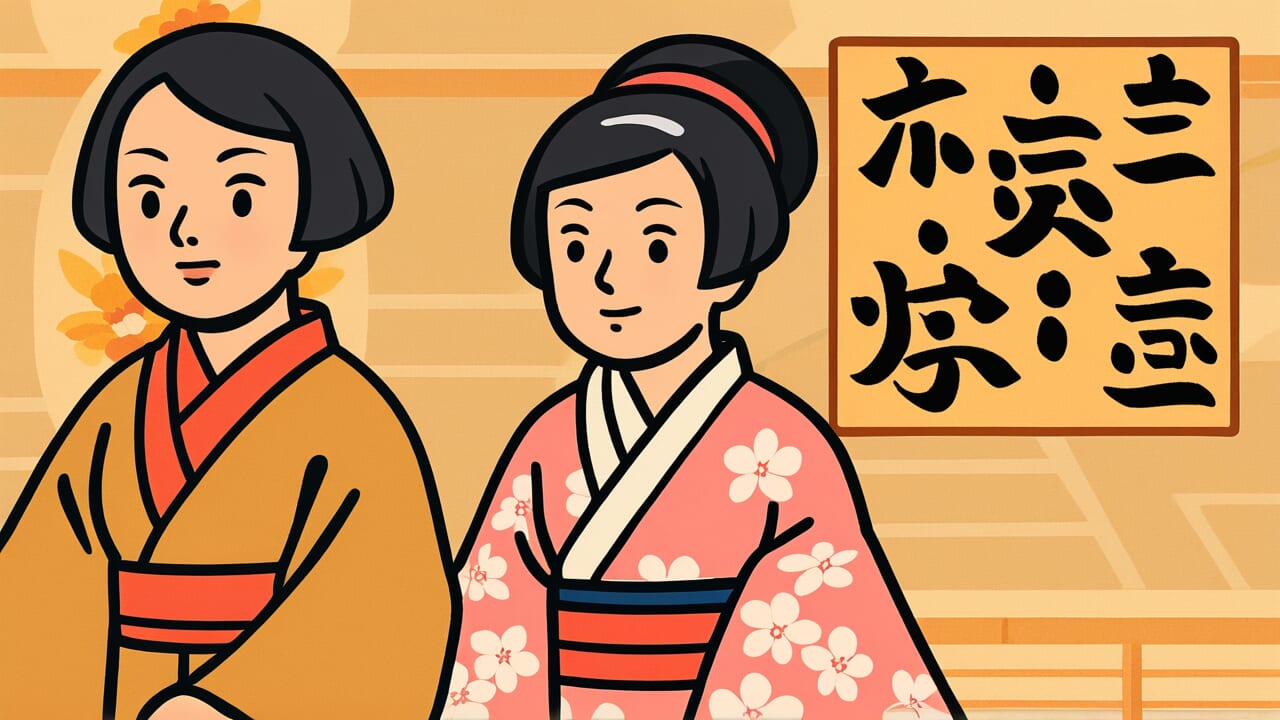How to Read “Furisode at thirty, shimada at forty”
Sanjū furisode shijū shimada
Meaning of “Furisode at thirty, shimada at forty”
This proverb teaches that you should dress and live in ways that match your age.
It warns against trying to look younger than you are or acting older than your years. Instead, it emphasizes the importance of dressing and behaving appropriately for your stage of life.
The proverb uses extreme examples to make its point. A thirty-year-old wearing furisode meant for young girls, or a forty-year-old styling her hair like an unmarried woman.
These images show how unnatural it looks when someone refuses to accept their age. They try too hard to appear younger or put on airs that don’t suit them.
People use this saying to gently warn someone whose appearance or behavior doesn’t match their age. It’s a soft way to suggest they should act more appropriately.
Today, fashion rules are much more relaxed. Strict age-based dress codes have largely disappeared.
But the core message of “Furisode at thirty, shimada at forty” remains relevant. It teaches the importance of being aware of your age and position in life.
The proverb encourages you to carry yourself with dignity and maturity that matches where you are in life.
Origin and Etymology
The exact origin of this proverb is unclear. However, it likely emerged from Edo period culture surrounding women’s hairstyles and kimono.
Furisode are kimono with long, flowing sleeves. Unmarried young women wore these bright, elegant garments as symbols of youth.
The shimada hairstyle, on the other hand, was typical for married women. It represented a calm, mature woman who had settled into adult life.
The combination in the proverb is actually age-inappropriate by the standards of that time. A thirty-year-old in furisode or a forty-year-old with a shimada hairstyle would have seemed odd.
During the Edo period, women typically married around age twenty. Still wearing furisode at thirty meant you were far past the usual age for marriage.
Similarly, wearing the shimada hairstyle at forty when it was meant for younger unmarried women was equally strange. The proverb points out how ridiculous and unnatural such age-inappropriate dress appears.
In that era’s strict social hierarchy, clothing wasn’t just fashion. Your dress showed your age and social position, helping maintain social order.
Against this background, the proverb spread as a lesson. It taught the importance of behaving and dressing in ways appropriate to your age and station.
Usage Examples
- If you keep imitating people in their twenties when you’re already fifty, people will laugh at you like “Furisode at thirty, shimada at forty”
- It’s important to have age-appropriate composure, so I try not to be like “Furisode at thirty, shimada at forty”
Universal Wisdom
This proverb has endured because it addresses a universal human psychology: our resistance to the passage of time.
Everyone wishes they could keep their youth and beauty. We all feel anxiety and fear about growing older.
That’s why we sometimes dress or act in ways that don’t match our age. Our ancestors gently but accurately pointed out this very human weakness.
What’s fascinating is that “Furisode at thirty, shimada at forty” isn’t just criticism. It contains deep life wisdom.
Growing older isn’t about losing things. It’s about gaining new charms and dignity. The proverb teaches this important truth.
Twenty-year-olds have their own beauty. Forty-year-olds have theirs. Each age has its appropriate radiance, and embracing that is true maturity.
The proverb also hints at the importance of self-awareness. Understanding and accepting what stage of life you’re in is fundamental to living richly.
Don’t cling to the past. Don’t rush toward the future. Instead, affirm who you are right now, in this moment.
This wisdom about how to live is condensed into these few simple words.
When AI Hears This
Human female fertility begins declining in the early thirties. After age thirty-five, it drops sharply.
This biological fact was shared as common knowledge for centuries before modern medicine proved it scientifically. The numbers “thirty” and “forty” in this proverb aren’t random.
They reflect the realistic boundaries of childbearing potential that humanity observed throughout its long history.
What’s interesting is that “Furisode at thirty, shimada at forty” focuses on decoration rather than age itself.
Evolutionary psychology shows that animals prioritize visual signals when choosing mates. Like a peacock’s feathers or a deer’s antlers, furisode and shimada hairstyles functioned as signals.
They broadcast the message: “I am of reproductive age.” When the signal doesn’t match biological reality, it loses credibility.
Looking deeper, this proverb exemplifies “honest signaling theory.” In nature, individuals who send false signals get weeded out.
Why? Because receivers stop trusting those signals. Social criticism of wearing youthful decorations at thirty or forty was actually evolutionary pressure.
It protected the reliability of signals for the whole group. This proverb captures a human instinct.
We seek proper correspondence between unchangeable biological facts like age and changeable cultural expressions like decoration. That instinct is condensed in these words.
Lessons for Today
“Furisode at thirty, shimada at forty” teaches you the importance of having courage to accept who you are now.
In modern society, we constantly compare ourselves to others on social media. We chase after youth endlessly. This makes it hard to honestly accept our age and position.
But true happiness begins when you affirm yourself as you are today.
Being age-appropriate isn’t about giving up or compromising. It’s about maximizing the charms and strengths that only your current age can offer.
Your twenties have their own passion and possibilities. Your forties have their own experience and depth.
The beauty of flowers blooming at each stage can’t be compared. They’re simply different kinds of beautiful.
What matters is honestly looking at where you are now. From there, do your best.
Don’t obsess over your past self. Don’t rush toward your future self. Treasure who you are in this present moment.
When you can live this way, you’ll shine brightest as yourself, regardless of your age.



Comments